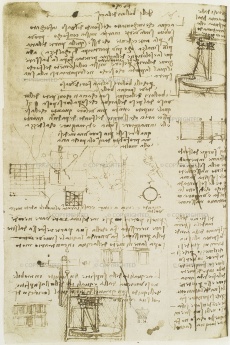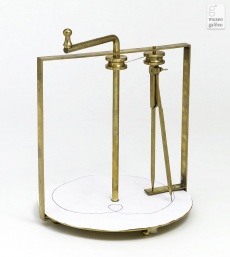Epicicloid Compasses
From Inventions
Has no specific name.
Contents |
Inventor
Leonardo da Vinci (1452-1519)
Historic Period
1490-1499.
Description
This compass, sometimes erroneously called tornio ovale, was invented by Leonardo for drawing epicycloids, a very particular curve used in constructing planetary clocks. In the Ptolemaic geocentric system with the heavens represented by crystalline spheres, one of the greatest problems was the anomalous motion of the planets, whose velocity varies throughout the year, giving rise to the seasons and days of different length. To solve this problem Ptolemy developed an ingenious theory of epicycles and deferents, in which each planet described an orbit (epicycle) around a centre, which in turn described an orbit (deferent) around the Earth. A planet completed one full revolution on the epicycle in the same time that the epicycle’s centre completed one full revolution around the Earth. As a result, each planet described a strange curve, called epicyclic, which allegedly explained the different velocities of planetary motion during the year. To build a planetary clock based on the Ptolemaic system, this strange motion around the Earth had to be mechanically simulated, by fabricating special epicyclic gears. Drawings of such gears by Leonardo are found in Madrid Ms. I (fol. 24 r). Obviously, their perfect construction depended on an equally perfect drawing of their curved contour. Such a curve could be drawn only with the aid of special compasses, one of them proposed by Dürer in his treatise on geometry. Leonardo’s compass basically replicates the motion of a planet. A wire transmitting the upper crank’s motion to the compass causes it to complete one full revolution around its own vertical leg in the same time that the horizontal disk with a sheet of paper completes one revolution on itself. The pen point on the compass thus traces a perfect epicycle.
Bibliographical Resources
Codice Arundel, c. 160v, Il codice Arundel 263 nella British Library, trascrizione e note critiche a cura di C. Vecce, ed. in facsimile nel riordinamento cronologico dei suoi fascicoli a cura di C. Pedretti, Giunti, Firenze 1998.
Dürer, Albrecht. Underweysung der Messung, mit dem Zirckel und Richtscheyt : in Linien Ebnen vo gantzen Corporen, Nürenberg, 1525, I, 40.
Camerota, Filippo. Compasso per parabole, in Nel segno di Masaccio. L'invenzione della prospettiva, catalogo della mostra, Firenze, Galleria degli Uffizi (16 ottobre 2001 - 20 gennaio 2002), Giunti, Firenze, 2001, p. 185.
Existing Instruments
Museo Galileo-Istituto di Storia della Scienza, modello funzionante (2001).
Links (External)
http://www.2dcurves.com/roulette/roulettee.html (English site about epicloids)
Images
Author of the entry: Filippo Camerota


